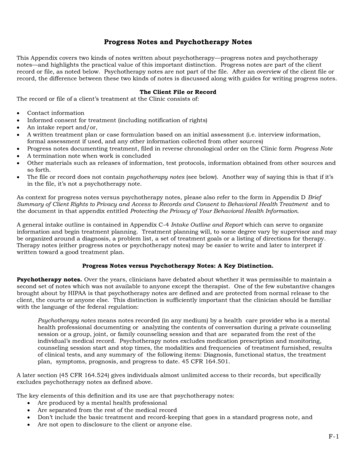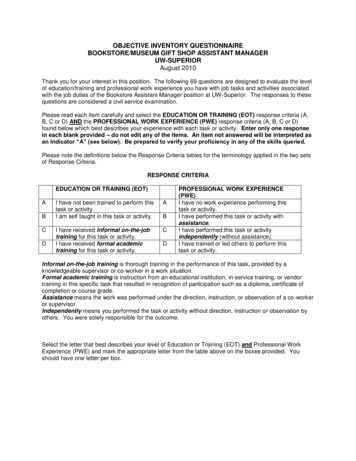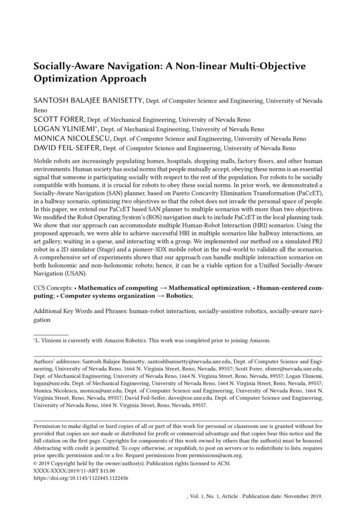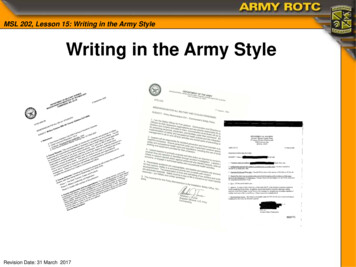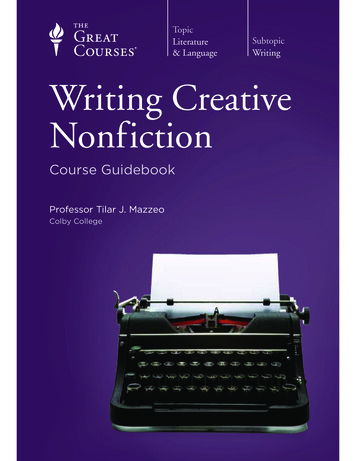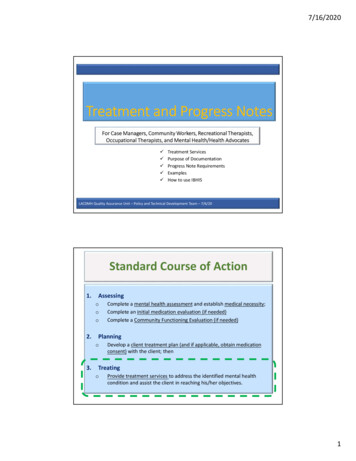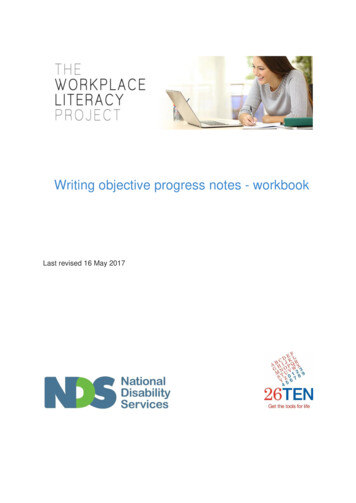
Transcription
Writing objective progress notes - workbookLast revised 16 May 2017
About the programThis training program is an action from the Tasmanian Disability Sector Language,Literacy and Numeracy Skills Action Plan 2016 - 2017.The aim is to train support workers and team leaders with the skills to writeobjectively.This program involves a one-hour, team-based training session.Session objectivesAt the end of this session you will be able to: Define objective writingRecognise the benefits of objective writingIdentify when to write objectivelyWrite objectively appropriate to workplace documentsNoteWe use the term “progress notes” to refer to the documents created by supportworkers at the end of a shift. The term you use might be different from this, but themeaning will be similar. Other terms you might use are: Daily notesShift reportsCommunication notes1
Why do we write progress notes?The purpose of writing progress notes is: 2Who reads the progress notes?The progress notes will be read and used by: What is done with the information in progress notes?How is the information used? What actions are taken based on the information?The information in progress notes is used to: What information needs to be reported in progress notes?The information we need to include in progress notes is:
DefinitionsObjective writingObjective writing is based on facts and observations. It is a description of whatactually happened.Ask yourself what did you: Hear?Say?See?Do?Objective writing is not influenced by personal feelings or opinions.Example of objective writingAt 3.30 pm Marcella returned from a walk to Albert Street Park andshe was holding her right arm against her body. I noticed that shehad a graze and bruise on her right arm. Marcella said a dog hadjumped on her when she was sitting on the grass at the park. Shesaid she had been frightened and that her arm was sore.Subjective writingSubjective writing is based on or influenced by the writer’s point of view, emotions,assumptions, speculation, judgement or interpretations.We are often subjective.Example subjective writingMarcella must have bumped into something when she went on awalk to Albert Street Park, as she has grazed skin and a bruise onher arm. She was holding her arm and looked unhappy.Be aware of objective and subjective writing1. Sort out the objective cards from the subjective cards.2. Match each objective card with the subjective card that bestreflects possible interpretations for the behaviour. This canbe based on your profession judgement, personal viewsand past experiences.3. Did all the groups pair the cards in the same way? Discuss the different waysthat objective behaviour can be interpreted. The objective behaviour couldindicate any one of the subjective descriptions.4. Can you see that writing subjectively might not present anaccurate account of what really happened?3
Benefits of writing objectivelyThe benefits of writing objectively are: 4
Getting startedFor progress notes think about: Why you’re writing the documentWho will read itWhat they will do with the informationThe goals in the person’s planAny specific things that the person’s team need information aboutThe order in which things happened (chronologically)Highlights or significant details of the shiftWhat actually happened:o What did the person say? How did they communicate this?o What did the person do?Writing objectively doesn’t mean that you can’t write about emotions orinterpretations. But first, you need to explain in your report what was saidand what you observed. Then you can then say, “I interpreted this tomean that the person was feeling .”This might be necessary in order to explain the actions you then took, orthe kinds of supports you provided.See the last two pages of this workbook for some further informationabout: Reporting active supportResponding to and reporting behaviours of concernYou can put these in an area where you write your progress notes, and use them asmemory joggers.5
Practice writing objective progress notesWork in pairs to re-write the following progress note objectively.(You can choose to use bullet points to make writing clearer).Some backgroundAnya is 31 years old, has an intellectual disability, and works at an organisation thatprovides business services. The goals articulated in her plan are about: Becoming more physically active for health and wellbeingLearning more about food choices to self-manage diabetesStrengthening her independent living skills so she and her partner can movein to their own accommodation togetherProgress notes for Anya – subjectiveAnya woke to her alarm at 6:30 am and got out of bed straight away without verbalprompting. She was a bit grumpy during the morning while getting ready to go towork. She weighed herself and was 86 kg. This is a 1 kg loss since last week so sheshould be happy with that. She wrote it on her chart and I helped. She decided tohave toast with jam for breakfast. I tried to give her the other light nut spread, but sherefused to eat it. She did her physio exercises for 15 minutes and was pretty good.She was ready on time to catch the bus to work at 8:30 am.6
Guidelines for writing objectivelyYour workplace might provide examples of your workplace documents duringinduction. Guidelines are sometimes also provided in relevant policies andprocedures.Does your workplace have any existing guidelines for writing objectively? Where canyou find them?7Be factualAsk yourself the following questions as a prompt to include all the requiredinformation. Who was involved?What happened?Where did it happen?When did it happen?What did they say, what did you hear?What did they do, what did you see?What did you do, what did you say?Reporting things you read or heard Did someone else tell me something, and I think I should record it?For example, during the evening shift, you found Nomara crying in her room. Whenwriting your progress notes, you want to include information passed on from thesupport worker who went with her to the community garden. Your report includes:Nomara had a good morning at the community garden. Sheplanted seedlings and ate some veggies.The support worker who took Nomara to the community gardenreported that she was active all morning. She planted seedlingsand picked some ripe tomatoes and ate them.Be accurate and specificThink about the information that all the readers need to get from your report. Includeenough detail for them to fulfil their role in the person’s team.The person was hot, and had a high temperature in the afternoon.The person’s said they felt hot. Their temperature was 39 at3pm.
Be logicalInclude the information in a chronological order.Re-read and edit subjective statements to become objective statementsRe-read your report and check that you have only reported the facts. Ask yourself,does this include anything I: Heard or read somewhere else?Assumed?Interpreted?Made a judgement about?Edit the document to remove the subjective statements and replace with objectivestatements.Henry was upset and accused Tamara of taking his phone. Imade him sit on the chair while I sorted it out.Henry raised his voice and pushed Tamara. He said, ‘She tookmy phone and hid it’. I asked Henry to sit in the chair while Italked to Tamara. I asked Tamara if she had the phone. She said‘No, I didn’t touch it’. She pointed to the table next to the chair.8
Practice writing objective progress notesWrite objective progress notes about your last shift.For progress notes think about: Why you’re writing the documentWho will read itWhat they will do with the informationThe goals in the person’s planThe order in which things happened (chronologically)Highlights or significant details of the shiftAny specific things that the person’s team need information aboutIs it fact? Did it definitely happen, what did you hear, say, do or observe?Also, see if you can: Identify other sources of informationBe accurate and specificChange subjective statements to be objectiveBe logicalDon’t forget to use the resources on the last two pages of this booklet if you can.9
10
Reporting active supportWhen you are reporting on the types of active support provided, explain the gradedassistance that was given during each activity. Verbal cues – you asked or invited the person to be involved Visual cues – you set the scene so that the person could see what activityyou were offering them Step-by-step instructions – you gave the person clear and simple promptsat each stage of the activity Sign and gesture – you moved your hands, arms, body or face tocommunicate an idea Show – you did the same activity next to the person so they could copy you Physical assistance – you provided some physical assistance to enable theperson to complete part of a task Hand over hand assistance – you placed your hand over a person’s hand tohelp them carry out a task Visual aids – you showed a person a picture or object to support them tomake a choice Adaptive equipment – the person used equipment to strengthen theirphysical or communication capabilitiesFor example: Nugget made a zucchini cake. He followed step-by-step instructions.Physical assistance was provided to pick the zucchini from the garden, use theelectric beater, put the cake in the oven, and remove it from the oven. He carried outmeasuring and mixing independently.Australian Government Department of Industry. (2015). ‘Every moment has potential:Module 3’. Retrieved, February 2017, -3.html
Responding to and reporting behaviours of concernCommon misinterpretations of behaviourExamples of alternative interpretationsAttention seekingThe person follows staff or family membersaround the house, touch othersinappropriately, attempts to pass objects atseemingly inappropriate times, teases others,interrupt others or act in a way that is found tobe annoying. Self-stimulatingThe person rocks, twists or plays with theirfingers and toes; slaps their face or their legspersistently; twirls around; pokes at theireyes; hums or signs inappropriately.Self-injuringThe person picks at their skin, cutsthemselves with sharp objects, places objectsin their body cavities, pulls their hair out, eatsor drinks to excess.Non-compliantThe person does not do things as they areasked to do them, when they are asked, ordoes not finish things they start.DisruptiveThe person talks or makes noises atinappropriate times, yells, interferes with thework or activities of others or break things. Initiating relationships – they want friendsSeeking company – they are lonelySeeking reassurance – they are scaredSeeking help or support – they lack skills orconfidencePersonality issues Bored, overwhelmed or over stimulated andmay need to calmUnable to identify or initiate an alternativeactivitySyndrome specific behaviours, possiblyrelated to neurological problemsHealth and medical needs NervousAnxiousDepressedPsychiatric issuesBored/Boredom Not interestedNot understandingNot being asked the right wayNot having sufficient skillsNot having sufficient stamina (tired)Recalling bad memories of a pastexperience FrightenedScaredStressedLacking understanding of the situation AggressiveThe person throws objects or hit out at others. Not knowing what is expected of themFrustrated or even threatenedThe requirements of the current situationexceed their skill or level of tolerance Other attempts to communicate are notresponded toDepartment of Human Services, Victoria. (20009). Positive behaviour support - Getting itright from the start: Facilitators reference manual V2. Retrieved, February 2017, the-start/1
Practice writing objective progress notes Work in pairs to re-write the following progress note objectively. (You can choose to use bullet points to make writing clearer). Some background Anya is 31 years old, has an intellectual disability, and works at an organisation that provides busine

